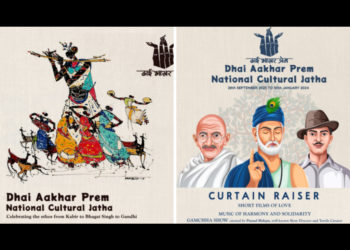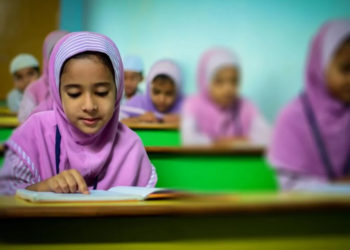Garrisoned Minds, recently published by Speaking Tiger, Delhi, is an attempt to put the collective ear to the ground and hear the voices muted by our media narratives. Most important, it takes note of the ways in which women face the might of the State. Each section begins with an introductory essay laying out the history of struggle in the geographical area in focus. The essays that follow probe the impact of militarisation on the lives of people. Vidhya from the ICF editorial collective spoke to the editors, Laxmi Murthy and Mitu Varma.
What are the material conditions that drive the political choices of the women of Kashmir? Women in Kashmir appear to be overwhelmingly speaking of Azadi. How do we locate this aspiration in the light of the history of militarisation?
With the two nuclear-armed neighbours upping the ante over Kashmir and both articulating territorial claims – ably assisted by the hyper nationalistic mainstream media, it is easy to forget the most important protagonists: the Kashmiris who breathe, live, work and play in this disputed territory.
The profound alienation which represents the dominant mood in the Kashmir Valley has deepened over the decades, and the assertion of a separate identity has been the hallmark of every period of insurgency. New Delhi has systematically used military power instead of dialogue and discussion to quell each upsurge of rebellion, and the Valley has earned the sobriquet of ‘one of the most militarised zones in the world’ with the blatant use of military might, legitimised by draconian national security laws.
Like in many parts of South Asia – with the exception of suicide bombers of the Liberation Tigers of Tamil Eelam (LTTE) – Kashmiri women have mainly played supportive and enabling roles to aid the armed insurgency fought by men. Feminine tasks such as cooking, mending uniforms, first aid, fund raising, recruitment, and sacrificing their brothers, husbands and sons to the cause rendered women’s involvement in the conflict traditionally gendered. Kashmiris have vehemently espoused the cause of Azadi in these roles, while also moving into surveillance; aiding financial transactions and other crucial but behind-the-scenes activities. Women have also been the bulwark of Kashmiri society, attempting to live their lives and nurture their families in the face of unspeakable human rights violations; enforced disappearances and combing operations and incredibly tough daily lives amidst curfews, shortages, lockdowns and roadblocks. Few complain, fired as they are by the vision of Azadi.
Women have been subjected to sexual violence, intimidation and indignities by the security forces, and few have dared to speak up. Breaking the silence has severe consequences, and without a cushion of support, few women have dared to take the risk.
The decades-long militancy in Kashmir, constantly up against the powerful Indian army, has spawned its own distortions in the shape of the counter insurgency, dragging women relatives of the hated Ikhwanis, or ‘surrendered militants’ into a vortex of betrayal, guilt and isolation. Garrisoned Minds, in an insightful essay by Shazia Yousuf (extracted here) touches upon an unspoken reality of Kashmir. Convenient labels of ‘victim’ and ‘perpetrator’ do not accurately fit those left behind to live out a “widowhood of shame”. This counter insurgency strategy left in its wake death, destruction, and families that could not hold up their heads in a land where pride and dignity are the foundation of the struggle for azadi—freedom. The women, who had little say in their husbands joining the Ikhwan, are torn between loyalty towards their men and that for their land, an independent Kashmir. Their alienation is complete, and their suffering is not on the agenda of even human rights groups.
The complex stories of the women of Kashmir demand recognition of the real perpetrators of injustice: a state that prohibits self-determination and an army that uses brute force as well as manipulation and devious means to suppress the aspirations for freedom.
Manipur and Naga resistance to occupation has tried to find a vocabulary of resistance that breaks the language of ‘patriarchal nationalism’ and the ‘language of rights (that) is predominantly masculine’ by weaving and wearing resistance. How do we try to build and nurture such languages of resistance?
The history of militarization and resistance in the hills and valleys of Manipur and Nagaland is as old as independent India itself. The struggle for a unified independent Naga homeland started with the Naga declaration of independence in 1947, spilling over to Manipur in the 1950s. This morphed into various ethnic constituencies and armed groups battling each other as well as the state for their rights. As Yirmian Arthur in her biographical essay in this volume titled “This Road I Know” on growing up as a young Naga woman traversing the land says, “How does one relate to age-old neighbours, waking up one day to see them at war?”
Women have often stepped in as peace-makers to bridge these divides, besides struggling against the overwhelming presence of the Indian army and the atrocities perpetrated by it in a bid to quell resistance. In her incisive essay “The Art of Defiance” (extracted here), Thingnam Anjulika Samom traces the trajectory of resistance by women to militarization and its inevitable corollary – sexual violence through silences, to speaking out through different modes of protest – including the dramatic nude protest in the Manorama case – to selective silences when the perpetrators are from the resistance movement, but across ethnic divides.
The calendar and the kashan remain living testimonies to Luingamla’s molestation and murder by two soldiers of the Indian army even three decades after the incident. It is a mode of protest evolved and organized by the Tangkhul Naga women of Manipur, putting in their own resources and effectively speaking of their struggles in the search for justice. It delineates their active role as resistors instead of “victims” to be subdued into silence since speaking out would bring dishonor to a land where the dominant patriarchal narrative sees women’s bodies as the repositories of nation, home and honour.
It is relatively easy to evolve effective means of protest when the perpetrator is the Indian army, which is seen as an outside occupying force. But it calls into question the dominant narratives of nationalism and resistance when the perpetrator is from a different community from within. The women themselves tend not to raise their voices on these issues. To build and nurture these modes of protest then becomes a challenge. Anjulika, on her part, calls for a collective response not only from women’s groups but also civil society organisations engaged in such nationalistic movements, to break this conspiracy of selective silence. Weaving and wearing resistance would then become a strong statement that upends patriarchal narratives of both nationalism and rights.
Weaving memory and resistance into effective symbols of defiance by women’s groups across the board and resistance movements across ethnic divides needs to be highlighted by media and brought into “mainstream” discourse, extolling their effectiveness in order to firmly ensconce these narratives in the collective consciousness. This is what we have sought to do both through the book and through articles and documentaries in mainstream media.
Widowhood of Shame
—Shazia Yousuf
The Art of Defiance
—Thingnam Anjulika Samon
Weaving resistance




